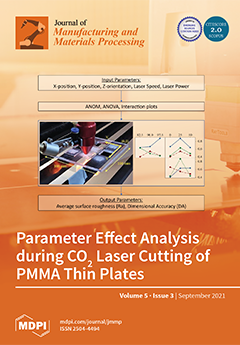This paper focuses on optimizing the laser engraving of acrylic plastics to reduce energy consumption and CO
2 gas emissions, without hindering the production and material removal rates. In this context, the role of laser engraving parameters on energy consumption, CO
2 gas
[...] Read more.
This paper focuses on optimizing the laser engraving of acrylic plastics to reduce energy consumption and CO
2 gas emissions, without hindering the production and material removal rates. In this context, the role of laser engraving parameters on energy consumption, CO
2 gas emissions, production rate, and material removal rate was first experimentally investigated. Grey–Taguchi approach was then used to identify an optimal set of process parameters meeting the goal. The scan gap was the most significant factor affecting energy consumption, CO
2 gas emissions, and production rate, whereas, compared to other factors, its impact on material removal rate (MRR) was relatively lower. Moreover, the defocal length had a negligible impact on the response variables taken into consideration. With this laser-process-material combination, to achieve the desired goal, the laser must be focused on the surface, and laser power, scanning speed, and scan gap must be set at 44 W, 300 mm/s, and 0.065 mm, respectively.
Full article





